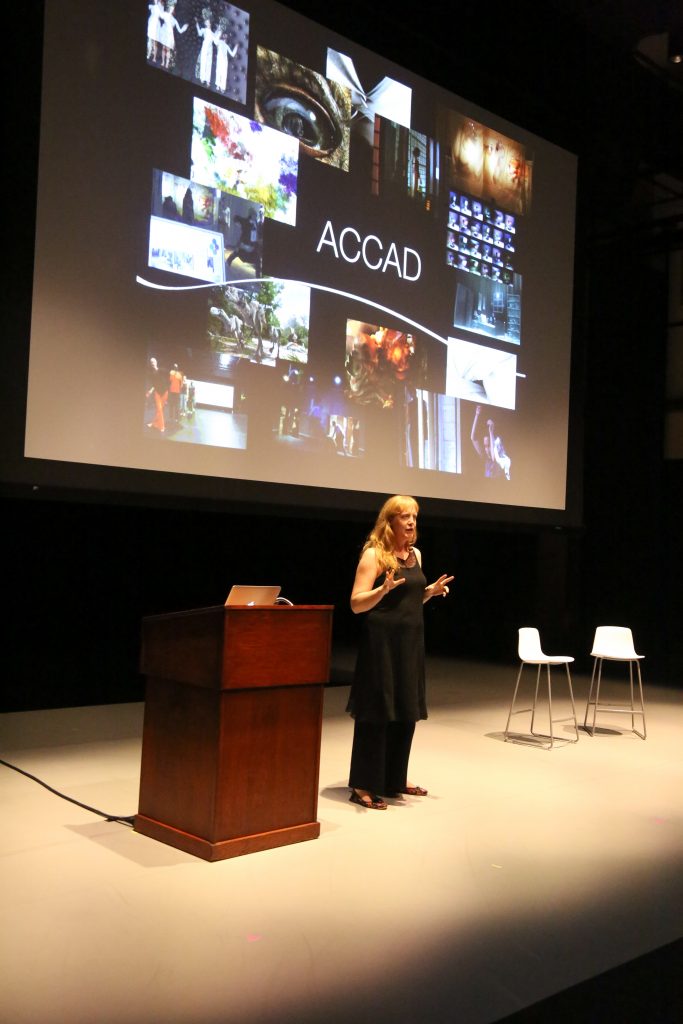USC Choreographic Institute launches with discussion about dance, data and technology
October 26, 2016

Norah Zuniga Shaw presents Futures in Motion | Photo by Carolyn DiLoreto
The USC Choreographic Institute presented a lecture the evening of Oct. 14 in the performance studio at the Glorya Kaufman International Dance Center featuring the research of Norah Zuniga Shaw and William Forsythe, co-creators with animator Maria Palazzi of the award-winning interactive web project Synchronous Objects. Their lecture and discussion, “Futures in Motion,” focused on expanding possibilities for the manifestation of dance and choreographic thinking. The lecture served as the central public event of the “Futures in Motion Summit” convened to launch the Institute in a community of local, regional and national leaders and change makers involved in innovative research in dance, technology and the wellness professions.
Forsythe, the artistic advisor of the USC Choreographic Institute, is a professor at the USC Glorya Kaufman School of Dance and a world-renowned choreographer.
Zuniga Shaw, a professor and director of dance and technology at The Ohio State University’s Department of Dance and Advanced Computing Center for the Arts and Design, has been a collaborator of Forsythe’s for the last decade. Synchronous Objects uses animation and computer graphics to visualize choreographic structure in Forsythe’s well-known ensemble work “One Flat Thing, reproduced.” Zuniga Shaw describes the project as “flowing from dance to data to objects.” She and her team generated data from the dance (gathered through interviews with the dancers as well as Forsythe) and then translated that data and the conceptual basis of the dance into various other forms. The animated representations range from lines between the dancers communicating cues and spatial patterns to more abstract volumes of motion and a rotating data fan. Many of these forms removed the image of the dancers entirely and reveal patterns in the choreography through animation.
“I think this project was the right place to ask ourselves the question, ‘is digital media the right place to start a literacy program for our particular practice?’” Forsythe said. He explained that Synchronous Objects was created to help viewers read the dance more comprehensively and see patterns that they would not have noticed before.
Shaw also spoke about broader concerns for dance today referencing curator and educator Simon Dove’s dichotomy of dance ‘as we know it’ in decline and dance ‘as we don’t know it’ on the rise, and suggesting the ways that interdisciplinary collaboration can forward discovery in the latter. With the recent push in accessibility to virtual reality software, Shaw explained, the future of dance and technology research broadens even further. During the lecture, Shaw discussed the future of Synchronous Objects as well as her current project, Collaboration for Humane Technologies, an initiative that proposes “arts-driven research foregrounding creativity, embodied and multisensory engagement with computing (through virtual reality, augmented reality and other means) and rising to the challenges of the 21st century through arts practices” Shaw explained.
In a lively discussion with Forsythe and Shaw after the talk, questions included a broad spectrum of ideas—from inquiry about the loss of a dancer’s live energy through technological translation to appreciation for Synchronous Objects as a teaching tool and discussion of what’s next for dance and live experience.
Audience member Beth Weinstein, a professor at the University of Arizona who studies architecture in relation to choreography, said the lecture lined up with a visit to Los Angeles and with her interest in Synchronous Objects and other Forsythe works.
“I am thrilled to see the interconnectedness between the dancers and the way the information is being constantly responded to, and how those kinds of things might be brought into an architectural practice,” she said.
Weinstein was not the only listener interested in the dancers’ connection. In response to another listener’s questions, the evening concluded with Forsythe’s words about preserving the community model in dance.
The Futures in Motion summit and lecture officially launches the USC Choreographic Institute, which aims to foster research and public dialogue at the intersection of dance, creative technologies and well-being and advocate for the social and cognitive value of movement.
By Celine Kiner